Cookies Glossary: A Glossary Of The Different Cookies TypesPage 9: Terms Beginning With S This is Page 9 of an 10-page article. Click on the red links below to visit other pages. This glossary is protected by copyright and cannot be reproduced in whole or part. You are welcome to link to it.
|
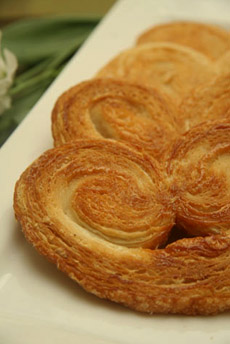 Palmier, or elephant ear, cookies from FinancierPastries.com. |
|
| SABLÉ or SANDY: A shortbread-like butter cookie with a sandy texture, sablé means “sand” in French and refers to both the color and the texture of the cookies. The cookies originated in the Normandy region of France and are a very popular tea cookie. Common variations include chocolate and lemon sablés. Some American bakers use the French translation, “sandy.” In some sandy recipes, the dough is lighter than traditional dense, buttery shortbread. A pecan sandy is simply the shortbread with chopped pecans added to the dough, or a pecan half embellishment on the top of the cookie. Here’s a recipe.
|
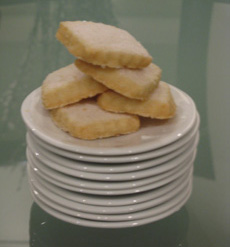 Sablés, shortbread, from Incredibly Edible Cookie Co. |
|
| SANDWICH COOKIE: A sandwich cookie is simply two cookies of any type, joined together with a filling. The most famous sandwich cookies are Oreos, but there are numerous other traditional sandwich cookies, from Nutter Butters to a variety of vanilla, chocolate and lemon creme sandwich cookies to whoopie pies. For a snack or dessert, set out a plate of individual cookies with various fillings (including ice cream!) and let people make their own sandwich cookies.
|
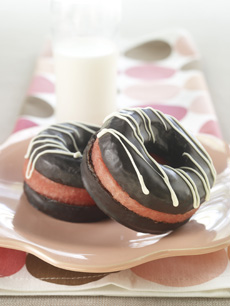 Sandwich cookies from NWPB. |
|
| SCHNECKEN: Schnecken are a specific type of rugelach: made with a sour cream dough (instead of cream cheese) and filled with raisins and chopped walnuts. Rugelach is rolled and sliced; schnecken are formed from individual triangles of dough. Many recipes rolled the pastry in cinnamon sugar prior to baking for an added crunch. The word “schnecken” means snail in German. While some recipes adhere to the original snail shape (see rugelach photo), others bake the cookie in the crescent shape, which, confusingly, is often called a snail shape by those who are trying to justify the name, “schnecken.”
|
||
| SCOTTISH SHORTBREAD: See shortbread.
|
||
| SHELL: A cookie baked in a madeleine pan, which produces elongated, shell-shaped cookies. This is a popular format for butter cookies. See madeleine.
|
||
| SHORTBREAD: Scottish in origin, these rich, tender and crumbly butter cookies were once only served during Christmas and New Year’s Eve. In French, this type of cookie is called a sablé. They are made in a variety of shapes and sizes: round, square, oblong, and fingers—even in the shape of baseballs (see Cooperstown Baseball Shortbread). Triangle-shaped shortbread cookies are known as petticoat tails. Read the history of shortbread.
|
 Shortbread fingers. Photo courtesy WholesomeSweeteners.com. |
|
| S’MORES: A sandwich cookie made of two graham crackers, a marshmallow and a square of chocolate. The marshmallow is toasted over a flame (originally a campfire); the hot marshmallow and the square of chocolate are sandwiched between the graham crackers. The heat of the toasted marshmallows melts the chocolate, creating a cookie sandwich so delicious that everyone asks for “s’more.” Read the history of s’mores.
|
 S’mores made with a gourmet kit from Recchiuti Confections. |
|
| SNICKERDOODLE or SNIPDOODLE COOKIE or CINNAMON SUGAR COOKIE: The snickerdoodle is one of the older cookie recipes, dating to the late 1800s. It is believed to have originated in New England, among Dutch or German immigrants. A butter cookie ball is rolled in a cinnamon-sugar mixture before baking and bakes into a flat cookie with browned, crisp edges. It is crisp on the outside and chewy on the inside.
|
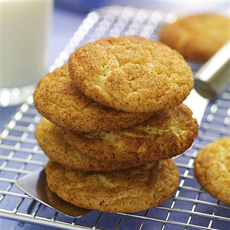 Snickerdoodles; get the recipe from McCormick.com. |
|
| SNOWBALL: A round, soft ball cookie.
|
||
| SPICE COOKIE: A hard cookie heavily spiced, usually with cinnamon and other spices such as clove and nutmeg.
|
||
| SPRINGERLE: A springerle mold or press in the form of a carved rolling pin, used to imprint a design onto a cookie; also, the cookies created by the process. After the designs are rolled onto the dough, the cookies are cut out. Springerles have been used in Austria and Bavaria for centuries to create Christmas cookies; sometimes they are enhanced with food coloring. The original carvings were of biblical scenes; eventually, secular scenes evolved. One could even have a springerle carved to depict marriages, births and other important events. If you know anyone who can carve well, a custom springerle would make an incredible gift!
|
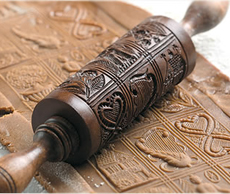 Springerle available from KingArthurFlour.com.
|
|
| SPRITZ COOKIE or SWEDISH BUTTER COOKIE or PRESSED BUTTER COOKIE: Spritz Cookies, also known as Swedish Butter Cookies or Pressed Butter Cookies, are a very popular Christmas cookie, not only in Scandinavia, but also here in North America. They have a lovely vanilla flavor and a rich buttery texture that is tender crisp. As their name implies, "Spritz" is German for "spritzen" meaning "to squirt", which is exactly what is done with this cookie dough. By that I mean we make these cookies using a cookie press (gun), a device that has a cylindrical barrel made of clear plastic and stainless steel with an easy-to-squeeze trigger, that "squirts" the soft dough through a decorative template giving us all sorts of wonderful looking cookies. We can make wreaths, flowers, trees, rosettes, stars, and stripes, to name a few. And while they are delicious plain, they look so pretty when decorated with candied cherries, nuts, colored sprinkles or colored sugars.
|
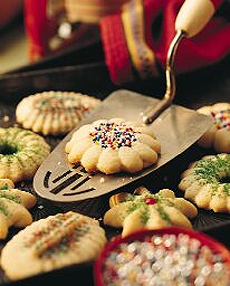 Spritz cookies give a lovely three-dimensional texture. Photo courtesy Wisconsin Milk Marketing Board. |
|
| SPUMENTE COOKIE: A crunchy round Italian cookie.
|
||
| SQUARE: A bar cookie cut in a square shape—chocolate square, lemon square, etc.
|
||
| STAINED GLASS COOKIE: A popular Christmas cookie, stained glass cookies are rolled and cut with a crimped or petal-edge cookie cutter; the centers are hollowed out with a small round cookie cutter and filled with crushed colored hard candies prior to baking. When baked, the candies look like stained glass. The cookies can also be hung as tree ornaments.
|
||
| STROOPWAFEL: An old Dutch treat, invented in the town of Gouda in 1784, the stroopwafel is a waffle-embossed sandwich cookie filled with a cramel-like syrup. The traditional way to eat it is with a cup of coffee, tea or cocoa. Just before it is eaten, the stroopwafel is placed on top of the hot cup in order to soften it up; the filling melts, and scents of cinnamon and nutmeg are released. Originally a poor man’s treat made from crumbs, the cookies are ubiquitous in Holland, from inexpensive supermarket varieties to artisan-baked cookies.
|
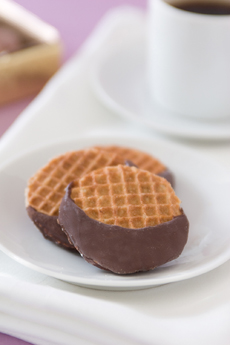 Stroopwafels dipped in chocolate from Dutch Moon. Photo by Saidi Granados | THE NIBBLE. |
|
| SUGAR COOKIE: This can mean two things: a cookie with made without butter (i.e., with shortening); or a cookie topped with sanding sugar (photo below). Many large, decorated novelty cookies (see photo at right) and “cookie bouquets” are sugar cookies. SWEDISH BUTTER COOKIE See spritz cookie. Go To Next Page: Cookie Terms With T To Z Go To The Article Index Above
|
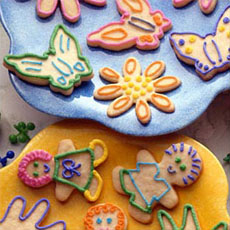 Sugar cookies. Photo courtesy LandOLakes.com. Below, cookies with sanding sugar, Photo courtesy King Arthur. 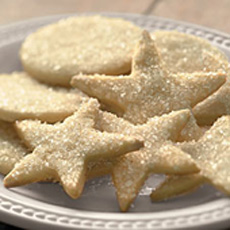 |
|
Last Updated May 2018
© Copyright 2005-2025 Lifestyle Direct, Inc. All rights reserved. All images are copyrighted to their respective owners.
